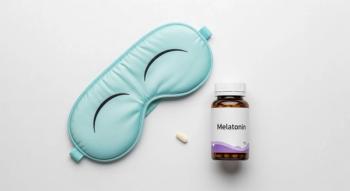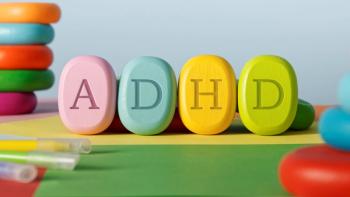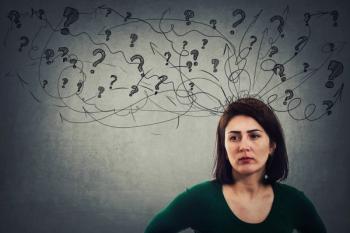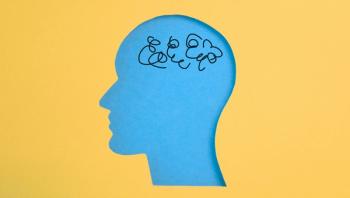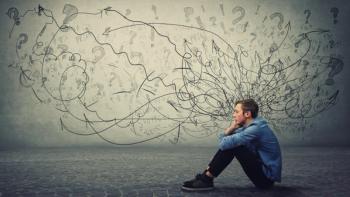SPECIAL REPORT: SLEEP DISORDERS
Sleep disorders encompass a range of conditions characterized by disturbances in sleep patterns and include insomnia, hypersomnia, circadian rhythm disturbances, parasomnias, sleep-related movement disorders, and sleep-related breathing disorders. Psychiatric symptoms often coexist with sleep disorders, creating diagnostic and therapeutic complexities. Understanding these psychiatric manifestations is crucial for clinicians to manage both sleep disorders and psychiatric conditions effectively (see the Table for sleep disorders, their associations with psychiatric illnesses, and management pearls). Sleep disturbances can exacerbate psychiatric symptoms, and conversely, psychiatric conditions often worsen sleep disorders, demonstrating a reciprocal relationship that warrants detailed exploration.
Insomnia Disorder
Chronic insomnia disorder is characterized by difficulties falling or staying asleep at least 3 times per week for at least 3 months, leading to functional impairment. Patients with insomnia disorder are 3 times more likely to develop anxiety and depression.1 Residual sleep disturbance in major depressive disorder (MDD) is associated with attenuated treatment effect and depressive relapse.2 The first-line treatment, cognitive behavior therapy for insomnia (CBT-I), has demonstrated a protective effect against incident and recurrent MDD.2 CBT-I and adapted formats have strong evidence for safely treating insomnia in comorbid bipolar disorder, anxiety, posttraumatic stress disorder (PTSD), and psychosis.3 Some patients with insomnia may receive on-label hypnotics such as Z-drugs and dual orexin receptor antagonists. For those with comorbid depression, sedating antidepressants such as trazodone or mirtazapine may treat both conditions.
Mechanistically, insomnia contributes to psychiatric symptoms through inappropriate sympathetic nervous activation, altered hypothalamic-pituitary-adrenal axis function, and greater systemic inflammatory response.4 Neuroimaging studies reveal that patients with chronic insomnia display differences in the anterior cingulate cortex, thalamus, insula, precuneus, and middle frontal gyrus.4
Central Disorders of Hypersomnolence
The most striking of the hypersomnolence disorders is narcolepsy. The narcolepsy disorders share symptoms of excessive daytime sleepiness, sleep paralysis, sleep-related hallucinations, and disturbed nighttime sleep, but they are differentiated by the presence of cataplexy and hypocretin deficiency in narcolepsy type 1. Another disorder is idiopathic hypersomnia, in which patients display the finding of short sleep latency on multiple sleep latency testing but the absence of abnormal sleep-onset REM periods. They may demonstrate a routine sleep duration of more than 660 minutes per 24 hours. Hypersomnolence itself may be seen in patients with major or bipolar depression. Depression and anxiety are found in 20% to 30% of individuals with narcolepsy.5 There is greater overlap of narcolepsy with psychotic disorders in individuals younger than 16 years, which may implicate a possible shared neurodegenerative mechanism.6 Hypocretin—a neurotransmitter that promotes wakefulness and suppresses REM sleep—is deficient in narcolepsy, which could be the result of an autoimmune reaction, head injury, tumor, or environmental effects.5 Care needs to be taken in diagnosis to differentiate the sleep-related hallucinations in narcolepsy from those in primary psychosis. Management of narcolepsy comorbid with schizophrenia can be particularly challenging, as conventional stimulants such as methylphenidates and amphetamines may precipitate or exacerbate positive psychotic symptoms.6 There have been case reports of psychosis secondary to sodium oxybate treatment.6 Modafinil and pitolisant have been used in such overlap cases to avoid exacerbation of psychosis.6 In the future, hypocretin agonists may hold promise to buttress alertness while avoiding psychosis exacerbation mechanistically.
Alexander Sweetman, PhD; Olga Papadopoulos, BSc, GradDipEd; and Marcia Balzer, BMus (Hons), GradDipCommMgt
Jean-Arthur Micoulaud-Franchi, MD, PhD; Christophe Gauld, MD, PhD; Julien Coelho, MD; and Jerome C. Wakefield, PhD, DSW, MSW, MA, BA
Circadian Rhythm Disorders
The circadian rhythm regulates several physiological functions, including alertness, hormone secretion, temperature regulation, and neurotransmitters important in psychiatric disorders. Misalignment of the circadian rhythm with the external light-dark cycle can lead to functionally impairing circadian rhythm disorders. These disorders are common in mood and anxiety disorders and schizophrenia, contributing to symptom exacerbation and reduced treatment efficacy.7,8 Exacerbation of psychiatric symptoms may partially be caused by excess exposure to artificial light, shift work, and travel between time zones. Circadian rhythm disturbances impact psychiatric health by disrupting melatonin secretion, cortisol rhythms, and neurotransmitter cycles.7 Specific polymorphisms of clock genes have been associated with seasonal depression, MDD, and delayed sleep-wake phase disorder (DSWPD).7 The severity of MDD is closely correlated with the extent of misalignment.7 Of note, an evening chronotype (a tendency for late sleep and wake times) is a strong risk factor for depression with greater severity of episodes and higher risk for suicidality.7 An evening chronotype is associated with greater severity of depressive symptoms and fewer manic episodes in bipolar disorder. Circadian mismatch in bipolar disorder appears to be bidirectional in association, and DSWPD is the most common comorbid circadian rhythm disorder.7 DSWPD is characterized by a circadian rhythm that is far delayed compared with norms. The imposition of socially acceptable sleep and wake times leads to insomnia.9 It disproportionately affects adolescents and young adults and is associated with a high rate of depression. Treatment by bright light and melatonin may normalize sleep and reduce depression.9 In Alzheimer disease dementia, patients may not exhibit any consistent pattern of sleep. Commonly seen in the disorder are day-night reversals, fragmented nighttime sleep, and exorbitant amounts of daytime sleep.10 This recurrent pattern of sleep disruption is pathognomonic for irregular sleep-wake type circadian rhythm disorder. In schizophrenia, a variety of sleep-wake changes have been noted, including both delayed sleep chronotypes and irregular sleep-wake patterns.8 The role of environmental cues, including exposure to natural daylight, regular meal timing, and consistent activity schedules, highlights the necessity of behavioral interventions alongside medical treatments to manage circadian-related psychiatric symptoms effectively.
Parasomnias
Parasomnias, divided into non-REM (NREM) parasomnias such as sleep talking/sleepwalking and sleep terrors, and REM parasomnias, such as nightmare disorder and REM sleep behavior disorder (RBD), frequently co-occur in psychiatric populations. NREM parasomnias, characterized by an incomplete dissociation between slow-wave sleep and wakefulness, may lead to complex sleep behaviors but with impaired recall. They tend to occur during the first third of the night, when slow-wave sleep predominates. They are seen in greater prevalence in psychiatric populations, particularly those who use antidepressants and Z-drugs.11 Of note, zolpidem has been implicated in precipitating sleepwalking and sleep-related eating disorder. Nightmare disorder, which is present in up to 90% of individuals with PTSD, is associated with greater anxiety and depressive symptoms and increased suicidality.11 RBD, characterized by dream enactment behaviors that can include both movements and speech due to loss of muscle atonia in REM sleep and can be associated with injury to the patient or bed partner, is strongly linked to a-synuclein disease, such as Parkinson disease, and is associated with depression.11 It generally occurs during the last third or half of the night, when REM sleep predominates. Those with RBD may recall their movements as congruent with dream content if awoken.
Clinical management of parasomnias include behavioral interventions such as avoidance of offending agents including alcohol and Z-drugs in NREM cases, placing barriers strategically with soft padding for the floor, and removing weapons and breakable objects from the bedroom to ensure safety. Pharmacological treatments may include high-dose melatonin for RBD and clonazepam in both RBD and NREM parasomnias after other sleep disorders have been ruled out or treated.12 Imagery rehearsal therapy, whereby patients rewrite the endings of their recurrent nightmares for the better, is effective in reducing nightmares in comorbid depression, anxiety, and PTSD, and it demonstrates early positive evidence in borderline personality disorder.13
Restless Legs Syndrome
Restless legs syndrome (RLS) is characterized by uncomfortable sensations in the extremities that usually occur in the hours preceding bedtime, leading to an urge to move that is worse with inactivity and improves with movement. This can cause difficulty with sleep initiation and maintenance, leading to sleep deprivation. It is associated with pregnancy, end-stage renal disease, neuropathy, and disturbances in iron and dopamine metabolism. It appears to be substantially associated with psychiatric pathology. Contemporary meta-analytic evidence shows that patients with RLS have a significant increase in depression and anxiety compared with controls.14 Mendelian randomization suggests that attention-deficit/hyperactivity disorder (ADHD) is an independent genetic risk factor for RLS, implicating shared dopaminergic and iron metabolism pathways and suggesting a greater relationship than mere symptomatic overlap.15 Large longitudinal cohorts demonstrate that RLS confers a 2 to 3-fold increase in suicide or self-harm risk even after adjustment for lifestyle factors, other sleep disorders, depression, and other chronic diseases.16 Treatment considerations in cases of comorbid depression and anxiety focus on medication selection. Many antidepressants may precipitate or exacerbate RLS, with bupropion being the exception.17 Treatment by dopamine agonists is not recommended because of the augmentation risks (symptoms worsening and requiring greater treatment doses to control) over time. Gabapentinoids are now considered the first-line pharmacotherapy.
Obstructive Sleep Apnea
Obstructive sleep apnea (OSA) describes recurrent upper airway collapse, usually associated with obesity and upper airway anatomical challenges. Consequently, patients experience hypoxic events and repeated disruptions from sleep throughout the night. This may mediate its association with depression, bipolar disorder, PTSD, insomnia, excessive daytime sleepiness, and cognitive impairment.18
OSA increases the risk of hypertension, stroke, myocardial infarction, and motor vehicle accidents. Untreated OSA significantly increases the risk of suicidal ideation even after controlling for depression and substance use.18 In the pediatric population, there is a well-established overlap of symptomatology between OSA and ADHD, where treatment of the former may spare patients from stimulant treatment.19
Continuous positive airway pressure therapy remains the cornerstone of treatment and has been demonstrated to lead to improvement in depression in comorbid cases, whereas evidence for mandibular advance devices appears negative for an effect on depression in a meta-analysis.20
Diagnostic and Clinical Implications
Accurate identification of sleep disorders alongside psychiatric disorders is essential. Clinicians should refer patients for polysomnography or home sleep testing when appropriate (eg, snoring, high body mass index, treatment-resistant hypertension, complex nighttime behaviors, RLS symptoms, or excessive daytime sleepiness). Early recognition and targeted treatment of sleep disorders may improve psychiatric outcomes, highlighting the need for integrated sleep-psychiatric care. Clinicians must also consider medication effects, substance use, and comorbid medical conditions that further complicate the relationships between psychiatric disorders. Collaborative care models integrating psychiatrists, sleep specialists, and primary care providers are needed to optimize patient outcomes.
Concluding Thoughts
Sleep disorders significantly contribute to psychiatric symptomatology, creating complex diagnostic and therapeutic challenges. Understanding the bidirectional relationship between sleep and psychiatric health is critical for effective clinical management. Enhanced awareness, precise diagnosis, and integrated therapeutic approaches can substantially improve both psychiatric and sleep outcomes. Future research should further elucidate underlying mechanisms, improve diagnostic accuracy, and optimize integrated treatment strategies.
Dr Mak is a psychiatrist and sleep medicine specialist at the Centre for Addiction and Mental Health and an assistant professor in the Department of Psychiatry at the University of Toronto. Dr Choi is a resident physician in the Department of Psychiatry at the University of Toronto. Mr Siddiqui is a student at McMaster University. Dr Tomatsu is a fellow at the Center for Circadian and Sleep Medicine in the Department of Neurology, Division of Sleep Medicine at Northwestern University and adjunct clinical assistant professor in the Department of Psychiatry at Wake Forest University in Charlotte, North Carolina. Dr Gazzellone is a clinical fellow in sleep disorder medicine in the Department of Psychiatry at the University of Toronto.
References
1. Hertenstein E, Benz F, Schneider CL, Baglioni C. Insomnia—a risk factor for mental disorders. J Sleep Res. 2023;32(6):e13930.
2. Mak MSB, Gebara MA, Lenze EJ, et al. Poor sleep is common in treatment-resistant late-life depression and associated with poorer antidepressant response: findings from the OPTIMUM clinical trial. Am J Geriatr Psychiatry. 2025;33(1):63-72.
3. Jansson-Fröjmark M, Norell-Clarke A. Cognitive behavioural therapy for insomnia in psychiatric disorders. Curr Sleep Med Rep. 2016;2(4):233-240.
4. Aquino G, Benz F, Dressle RJ, et al. Towards the neurobiology of insomnia: a systematic review of neuroimaging studies. Sleep Med Rev. 2024;73:101878.
5. Bassetti CLA, Adamantidis A, Burdakov D, et al. Narcolepsy—clinical spectrum, aetiopathophysiology, diagnosis, and treatment. Nat Rev Neurol. 2019;15(9):519-539.
6. Hanin C, Arnulf I, Maranci JB, et al. Narcolepsy and psychosis: a systematic review. Acta Psychiatr Scand. 2021;144(1):28-41.
7. Dollish HK, Tsyglakova M, McClung CA. Circadian rhythms and mood disorders: time to see the light. Neuron. 2024;112(1):25-40.
8. Wulff K, Dijk DJ, Middleton B, et al. Sleep and circadian rhythm disruption in schizophrenia. Br J Psychiatry. 2012;200(4):308-316.
9. Rahman SA, Kayumov L, Shapiro CM. Antidepressant action of melatonin in the treatment of delayed sleep phase syndrome. Sleep Med. 2010;11(2):131-136.
10. Zhang Y, Ren R, Yang L, et al. Sleep in Alzheimer’s disease: a systematic review and meta-analysis of polysomnographic findings. Transl Psychiatry. 2022;12(1):136.
11. Waters F, Moretto U, Dang-Vu TT. Psychiatric illness and parasomnias: a systematic review. Curr Psychiatry Rep. 2017;19(7):37.
12. Hurwitz TD, Howell M, Khawaja IS. Parasomnias: a review for psychiatrists. FOCUS J Lifelong Learn Psychiatry. 2014;12(1):16-30.
13. Sayk C, Koch N, Stierand J, et al. Imagery rehearsal therapy for the treatment of nightmares in individuals with borderline personality disorder—a pilot study. J Psychiatr Res. 2025;182:34-41.
14. An T, Sun H, Yuan L, et al. Associations of anxiety and depression with restless leg syndrome: a systematic review and meta-analysis. Front Neurol. 2024;15:1366839.
15. Xiao G, Shi H, Lan Q, et al. Association among attention-deficit hyperactivity disorder, restless legs syndrome, and peripheral iron status: a two-sample Mendelian randomization study. Front Psychiatry. 2024;15:1310259.
16. Zhuang S, Na M, Winkelman JW, et al. Association of restless legs syndrome with risk of suicide and self-harm. JAMA Netw Open. 2019;2(8):e199966.
17. Silber MH, Buchfuhrer MJ, Earley CJ, et al. The management of restless legs syndrome: an updated algorithm. Mayo Clin Proc. 2021;96(7):1921-1937.
18. Benca RM, Krystal A, Chepke C, Doghramji K. Recognition and management of obstructive sleep apnea in psychiatric practice. J Clin Psychiatry. 2023;84(2):22r14521.
19. Urbano GL, Tablizo BJ, Moufarrej Y, et al. The link between pediatric obstructive sleep apnea (OSA) and attention deficit hyperactivity disorder (ADHD). Children (Basel). 2021;8(9):824.
20. Fu W, Li L, Zhang S, et al. Effects of CPAP and mandibular advancement devices on depressive symptoms in patients with obstructive sleep apnea: a meta-analysis of randomized controlled trials. Sleep Breath. 2023;27(6):2123-2137.

